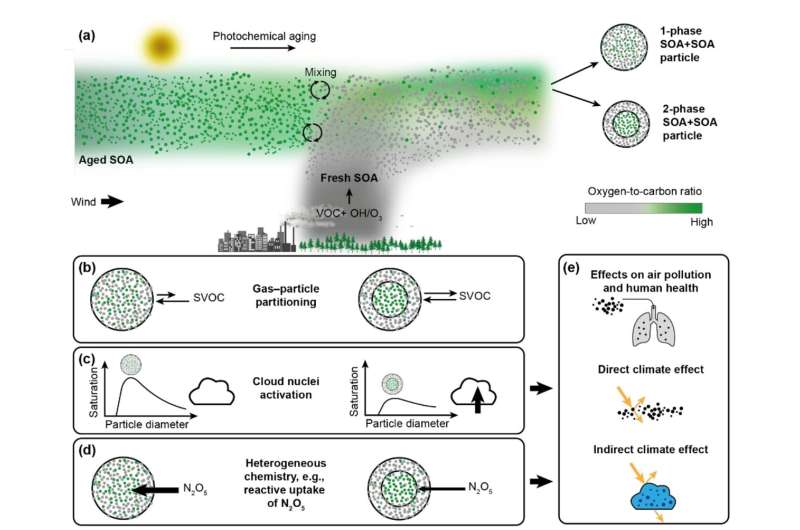Scientists uncover new clues about the climate and health impact of secondary organic aerosol particles

Peering inside common atmospheric particles is providing important clues to their climate and health effects, according to a new study by University of British Columbia chemists.
Secondary organic aerosol (SOA) particles are ubiquitous in the atmosphere and play an important role in air quality and climate. They can add to air pollution and damage the lungs, as well as help deflect solar radiation or aid cloud formation.
Different types of SOA can mix together in a single particle and their environmental impacts are governed by the new particles' physical and chemical properties, particularly the number of phases—or states—it can exist in.
In a new research letter published in Atmospheric Chemistry and Physics, an international team of researchers found that particles with two phases can form when different types of SOA mix. The finding could help improve current models that predict SOA climate and health effects.
"Up until now, models have often assumed that when SOA types mix into the same particle, they have just one phase. But we found that's not always the case, meaning current models might not correctly capture some of these effects," says lead author Fabian Mahrt, a postdoctoral fellow at the Paul Scherrer Institute and UBC Department of Chemistry.
The team found that six out of 15 mixtures of two SOA types commonly found in the atmosphere resulted in two-phase particles. Importantly, they also discovered that the number of phases depends on the difference in the average oxygen-to-carbon ratio between the given SOA types. It's a fairly simple but potentially powerful way to represent such effects in models. When this difference is 0.47 or higher, the researchers found particles would have two phases.
"Now we can work with very complex organic molecules, calculate a single parameter which gives us information about the properties of a particular SOA mixture, and then potentially map quite large-scale impacts," says aerosol scientist and senior author Allan Bertram, professor in the UBC Department of Chemistry.
This kind of SOA mixing might occur include when plumes of SOA particles, which have been in the atmosphere for some time, blow from rural environments over cities where newly produced SOA particles are being emitted, explains Mahrt.
"If we assume this mixing of the plumes forms particles with a single phase, we might over-predict the total organic particulate mass in these areas, and so, the effects on those people's health." The team of scientists hopes the finding can help improve models and ultimately ensure that policies and regulations are based on a rigorous scientific understanding.
Building on previous work, the researchers used fluorescence microscopy to look inside the mixed SOA particles in their current experiments, injecting them with a dye that causes the particle phases to emit different colored light depending on their polarity. The researchers then used these colors to directly infer the number of phases of the mixtures, providing a direct visual proof of multiple phases.
"The study is evidence that we need to look at this phenomenon more carefully to get the full picture. We have one more piece of the puzzle but we have not necessarily finished the jigsaw yet," says Mahrt. The research team hopes other scientists will now extend the number of SOA mixtures experimentally, as well as include the findings in atmospheric models going forward.
More information: Fabian Mahrt et al, Not All Types of Secondary Organic Aerosol Mix: Two Phases Observed When Mixing Different Secondary Organic Aerosol Types, Atmospheric Chemistry and Physics (2022). DOI: 10.5194/acp-2022-331
Journal information: Atmospheric Chemistry and Physics
Provided by European Geosciences Union



















